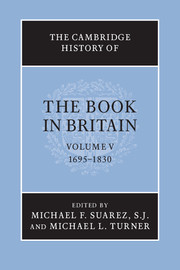Book contents
- Frontmatter
- Introduction
- PART I THE QUANTITY AND NATURE OF PRINTED MATTER
- PART II ECONOMIC, LEGAL AND CULTURAL CONTEXTS
- PART III THE TECHNOLOGIES AND AESTHETICS OF BOOK PRODUCTION
- 7 The technologies of printing
- 8 The industrialization of the paper trade
- 9 A year’s work in the London printing house of the Bowyers
- 10 Book illustration and the world of prints
- 11 The morphology of the page
- 12 Bookbinding in the eighteenth century
- PART IV THE BOOK TRADE AND ITS MARKETS
- V BOOKS AND THEIR READERS
- Abbreviations used in bibliography
- Bibliography
- Index
- Frontispiece
- Plate section
- References
12 - Bookbinding in the eighteenth century
from PART III - THE TECHNOLOGIES AND AESTHETICS OF BOOK PRODUCTION
Published online by Cambridge University Press: 28 September 2010
- Frontmatter
- Introduction
- PART I THE QUANTITY AND NATURE OF PRINTED MATTER
- PART II ECONOMIC, LEGAL AND CULTURAL CONTEXTS
- PART III THE TECHNOLOGIES AND AESTHETICS OF BOOK PRODUCTION
- 7 The technologies of printing
- 8 The industrialization of the paper trade
- 9 A year’s work in the London printing house of the Bowyers
- 10 Book illustration and the world of prints
- 11 The morphology of the page
- 12 Bookbinding in the eighteenth century
- PART IV THE BOOK TRADE AND ITS MARKETS
- V BOOKS AND THEIR READERS
- Abbreviations used in bibliography
- Bibliography
- Index
- Frontispiece
- Plate section
- References
Summary
Likewise with books bound after what manner you please.
It is as well to remember this statement when looking at the work of the hundreds of binders active throughout the United Kingdom over the period covered by this volume, who would have laboured for much of the time on individual commissions from retail booksellers (if they did not serve this function themselves), institutional libraries or private individuals, seeking to have books bought in sheets, paper wrappers or other temporary bindings put into permanent ones. For most of the eighteenth century, only the very cheapest end of the trade, such as school-books, popular romances and devotional works, typically sold books bound and delivered direct to the end-user, though the sale of bound bibles and liturgical works was something of an exception to that. It is in the second decade of the nineteenth century that significant numbers of editions were for the first time issued bound in what were intended to be permanent bindings. It is also important to remember that the bindings we know best from the literature – generally the more extensively decorated bindings – formed only a very small part of the trade. This chapter will therefore take as its main focus the more standard types of binding and the more ephemeral protection offered to text blocks within the book trade; the reader is directed to the existing literature for a more detailed accountof the more extensively decorated books.
- Type
- Chapter
- Information
- The Cambridge History of the Book in Britain , pp. 268 - 290Publisher: Cambridge University PressPrint publication year: 2009
References
- 1
- Cited by

